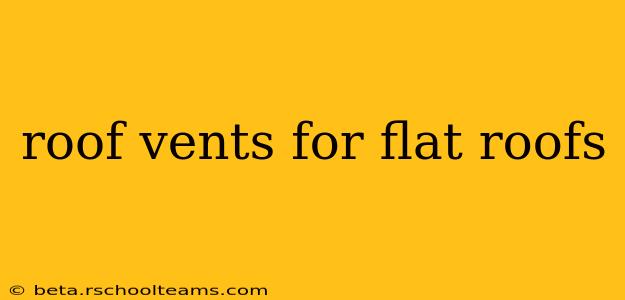Flat roofs, while aesthetically pleasing and offering potential for extra usable space, present unique challenges when it comes to ventilation. Proper ventilation is crucial for preventing moisture buildup, extending the lifespan of your roof, and maintaining a comfortable indoor environment. This guide delves into the world of roof vents for flat roofs, exploring various types, their applications, and how to choose the right solution for your specific needs.
What are the Different Types of Roof Vents for Flat Roofs?
Several types of vents cater specifically to the needs of flat roofs. Understanding their differences is key to making an informed decision:
-
Low-Profile Vents: These vents sit low to the roof surface, minimizing their visual impact and making them ideal for aesthetically sensitive projects. They often feature a sleek design and are available in various materials, such as aluminum or plastic.
-
Curb-Mounted Vents: These vents are installed on top of a curb, a raised structure built on the roof. The curb provides a mounting platform and improves airflow efficiency. Curb-mounted vents are often preferred for larger ventilation needs.
-
Solar-Powered Vents: These energy-efficient options use solar power to operate a fan, actively drawing out hot, moist air. They are particularly beneficial in areas with intense sunlight.
-
Static Vents: These vents rely on natural convection to draw out air. While less powerful than powered vents, they are simpler to install and require no maintenance beyond occasional cleaning.
-
Ridge Vents (for slightly sloped flat roofs): While technically designed for sloped roofs, some ridge vents can be adapted for flat roofs with a very slight incline. They offer efficient ventilation by drawing air from under the roofing material.
What are the Benefits of Using Roof Vents on a Flat Roof?
The benefits of installing appropriate roof vents on a flat roof are numerous and crucial for long-term roof health and indoor comfort:
-
Preventing Moisture Buildup: Proper ventilation prevents moisture from accumulating under the roofing material, reducing the risk of mold, mildew, and rot. This is especially important in climates with high humidity or frequent rainfall.
-
Extending Roof Lifespan: By preventing moisture damage, roof vents significantly extend the lifespan of your flat roof, saving you money on costly repairs or replacements in the long run.
-
Improving Indoor Air Quality: Vents help regulate indoor temperatures and humidity levels, leading to a healthier and more comfortable living environment.
-
Reducing Energy Costs: Effective ventilation can reduce the load on your HVAC system, resulting in lower energy bills.
How Do I Choose the Right Roof Vent for My Flat Roof?
Selecting the optimal roof vent involves considering several factors:
-
Roof Size and Pitch: Larger roofs will require more ventilation than smaller ones. Even slightly sloped flat roofs might benefit from different vent types compared to completely flat ones.
-
Climate: In humid climates, more powerful ventilation is often necessary. Solar-powered vents may be particularly suitable in sunny areas.
-
Budget: Vents range in price, from relatively inexpensive static vents to more costly solar-powered models.
-
Aesthetics: Consider the overall appearance of your building and choose vents that complement its design.
-
Building Codes: Always ensure that the chosen vent complies with local building codes and regulations.
How Much Does it Cost to Install Roof Vents on a Flat Roof?
The cost of installing roof vents on a flat roof varies depending on several factors, including:
- Type of vent: Different vents have different price points.
- Number of vents required: Larger roofs need more vents.
- Labor costs: Installation costs can vary significantly depending on your location and the installer's rates.
- Accessibility of the roof: Difficult-to-access roofs might increase labor costs.
It's advisable to obtain multiple quotes from reputable contractors to get a clear understanding of the total cost involved.
Are Roof Vents Necessary for Flat Roofs?
While not always strictly mandated by building codes, roof vents are highly recommended for flat roofs. The potential for moisture damage and the resulting costly repairs far outweigh the cost of installing proper ventilation. Considering the long-term benefits, including extended roof lifespan, improved indoor air quality, and energy savings, investing in roof vents is a wise decision for any flat-roofed building.
What are the Common Problems with Flat Roof Vents?
While generally reliable, flat roof vents can encounter certain issues:
- Clogging: Debris such as leaves or other materials can clog vents, reducing their effectiveness. Regular cleaning is crucial.
- Leaks: Improper installation can lead to leaks around the vent. Ensure your installer is experienced and uses appropriate sealing techniques.
- Damage from extreme weather: Extreme weather conditions like hail or strong winds can sometimes damage vents. Choose durable, weather-resistant materials.
This comprehensive guide provides a solid foundation for understanding the importance and intricacies of selecting and installing roof vents for flat roofs. Remember to consult with a qualified roofing professional for personalized advice tailored to your specific needs and local conditions.
